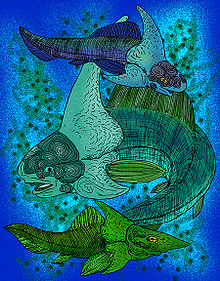Murrindalaspis is an extinct genus of acanthothoracid placoderm found in the McLarty Member of the Murrindal Limestone, of the Early Devonian-aged Buchan Group in eastern Victoria, Australia.[1] Murrindalaspis differs from other acanthothoracids by having a dorsal plate with a large, blade-like flattened, recurved crest emanating from the medial line, and no ventral keel. So far, the genus is known only from dorsal plates and ossified eyeballs. The genus differs from the closely related Weejasperaspis in that the dorsal crest of the latter is shorter, and triangular-shaped.
| Murrindalaspis Temporal range: Early Devonian
| |
|---|---|

| |
| Weejasperaspis gavini, Murrindalaspis wallacei & Brindabellaspis stensioi | |
| Scientific classification | |
| Kingdom: | |
| Phylum: | |
| Class: | |
| Order: | |
| Family: | |
| Genus: | Murrindalaspis
|
| Type species | |
| Murrindalaspis wallacei Long 1984
| |
| Species | |
| |
Species edit
There are two species in the genus. M. wallacei, the type species, has a high dorsal medial crest. The second species, M. bairdi, has a much lower crest, a groove along the median line of the ventral side of the dorsal plate, and somewhat coarser tubercles on the dermal surfaces of its armor.
References edit
- ^ Long, J. A. (1984). "New placoderm fishes from the Early Devonian Buchan Group, eastern Victoria". Proceedings of the Royal Society of Victoria. 96 (4): 173–186. ISSN 0035-9211.
External links edit